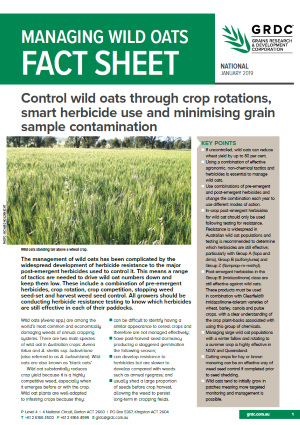Managing Wild Oats
Managing Wild Oats
Published: 1 Jan 2019
The management of wild oats has been complicated by the widespread development of herbicide resistance to the major post-emergent herbicides used to control it. This means a range of tactics are needed to drive wild oat numbers down and keep them low. These include a combination of pre-emergent herbicides, crop rotation, crop competition, stopping weed seed-set and harvest weed seed control. All growers should be conducting herbicide resistance testing to know which herbicides are still effective in each of their paddocks.
Key Points
- If uncontrolled, wild oats can reduce wheat yield by up to 80 per cent.
- Using a combination of effective agronomic, non-chemical tactics and herbicides is essential to manage wild oats.
- Use combinations of pre-emergent and post-emergent herbicides and change the combination each year to use different modes of action.
- In-crop post-emergent herbicides for wild oat should only be used following testing for resistance.
- Resistance is widespread in Australian wild oat populations and testing is recommended to determine which herbicides are still effective; particularly with Group A (fops and dims), Group B (sulfonylurea) and Group Z (flamprop-m-methyl).
- Post-emergent herbicides in the Group B (imidazolinone) class are still effective against wild oats. These products must be used in combination with Clearfield® imidazolinone-tolerant varieties of wheat, barley, canola and pulse crops, with a clear understanding of the crop plant-backs associated with using this group of chemicals.
- Managing large wild oat populations with a winter fallow and rotating to a summer crop is highly effective in NSW and Queensland.
- Cutting crops for hay or brown manuring can be an effective way of weed seed control if completed prior to seed shedding.
- Wild oats tend to initially grow in patches meaning more targeted monitoring and management is possible.
Download PDF
Region: National

